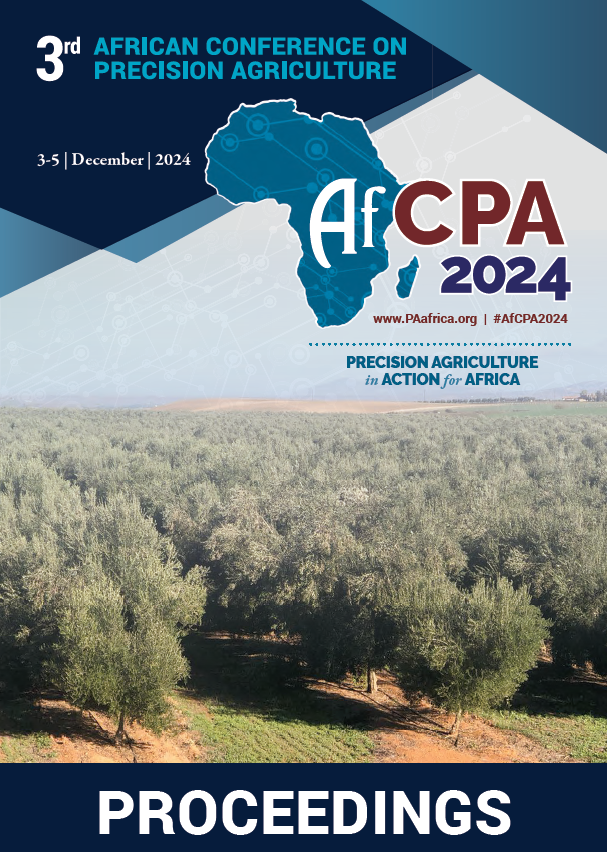Download the Conference Proceedings
Proceedings
Authors
| Filter results8 paper(s) found. |
|---|
1. Acceptance and Usage of Agri-tech in smallholder Chinese systems: Lesson learnt and implications for other small-holder farming systems.This paper will present a synthesis of activities performed in a collaborative UK-China project (PAFiC - 2015-2019) aimed at achieving a better understanding of the translation of precision agriculture (PA) technologies into small farms in China. The intent is to outline the farmer-focused approach that was used in the PAFiC project and the tools developed to understand PA adoption trends in China. Finally, we consider the potential implications of the outputs from PAFiC for promoting... J. Taylor |
2. FARMER CHARLIE: PRECISION AGRICULTURE AT SMALLHOLDER FARMERS’ SERVICEPreliminary research and an ongoing project in Nigeria showed that agriculture is a crucial activity in the country. It is mainly carried out in small, family-owned farms: in fact, 88% of Nigeria farmers work on less than 0.5 ha. Lack of resources, of readily available information and the impact of climate on agricultural activities lead to low yields and high-cost farm inputs (FAO, 2020). The availability of agricultural data and weather forecast information could play an essential role in improving... B. Bonnardel, G. Cursoli |
3. Scaling Precision Agriculture in West Africa Smallholder Irrigation and Water Management SystemsThe advent of precision agriculture (PA) is changing global agricultural productivity; through the underlining principles that ensure inputs required for the management of soil, water and crop agronomy are supplied precisely across the field landscape resulting in optimum yield. The benefits of PA include improved food security through increases in water and nutrient use efficiency, and timely management of good agricultural practices. The practice of PA could be beneficial across commercial –... A.O. Oke, V. Aduramigba-modupe |
4. Methodology for Assessing Nutrient Status of Nigeria Croplands: AfSIS/NiSIS Pilot Project - Pathway for Precision Agriculture MappingInherently low soil fertility, nutrient imbalances and accelerating degradation constitute threats to precision agriculture (PA), agricultural productivity and ecosystem services in sub-Saharan Africa (Nigeria inclusive). Presently, the geographical extent of existing nutrient constraints, location specific trends and opportunities for managing these over time are highly uncertain. The AfSIS/NiSIS project assessment aims to provide spatially explicit observations, measurements and predictions... V. Aduramigba-modupe, I. Amapu, M. Walsh, B. Scott |
5. détermination du bilan minéral partiel des exploitations agricoles à base du coton à l’aide du modèle NUTMONLa dégradation des sols des exploitations agricoles constitue ces dernières années une des causes principales des baisses de rendements au champ. A cet effet, la détermination quantitative des éléments nutritifs des sols cultivés peut contribuer à concevoir des stratégies de gestion durable de la fertilité de ces sols. C’est dans cette optique que 30 exploitations agricoles à base de coton ont été... A. Komlan, K. Kokou zovodu, A. Bassarou, G. Esso-iheyou, P. Justin |
6. Improving Phosphorus Use Efficiency by Chickpea Crop Using Electromagnetic Induction, Soil Properties, and Crop Yield Data Under Semi-arid ConditionsUnder arid and semi-arid conditions, the agricultural sector faces many challenges related to the use of water and mineral resources for crop production and food security for an exponentially growing population. The impact of climate changes on water resources availability and soil quality is more and more emphasized under the Mediterranean basin, mostly characterized by drought and extreme weather conditions. The present study aims to investigate how electromagnetic induction technique and soil... M. Chtouki, A. Oukarroum, F. Nguyen |
7. New Trends in Precision Agriculture Management: Africa PerspectiveThe ever-increasing human population in Africa demands a corresponding increase in food and fiber production. Although Africa has the 12th highest population growth rates in the world which may double by 2050, food productivity in the region has remained low. A critical challenge facing crop production in Africa is low awareness of precision agriculture (PA) and low soil fertility in many agroecosystems. Available studies show that digital technology is transforming the agricultural sector... V. Aduramigba-modupe |
8. Fine-tuning Specialty Fertilization Strategies to Local Wheat Production Through On-farm Experimentation in NigeriaWheat specialty fertilizer validation trial was conducted in 8 Local Government Areas (LGAs) of Kano State, Nigeria on farmers field. The specialty fertilizer validation project is implemented to improve the productivity and profitability of small-scale wheat smallholder farmers. Four treatments - absolute control (AC), local control (LC), OCP1 and OCP2 were replicated four times in a RCBD on a plot of 25m2. The AC was based on the indigenous nutrient supply from the soil (no application... V. Aduramigba-modupe, J.M. Jibrin, . Olabanji, B. Lawan, D. Madukwe |
